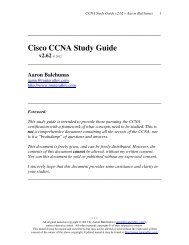Open Shortest Path First (OSPF) - Router Alley
Open Shortest Path First (OSPF) - Router Alley
Open Shortest Path First (OSPF) - Router Alley
You also want an ePaper? Increase the reach of your titles
YUMPU automatically turns print PDFs into web optimized ePapers that Google loves.
<strong>OSPF</strong> v1.31 – Aaron Balchunas<br />
23<br />
<strong>OSPF</strong> Area Types (continued)<br />
Totally Stubby Area – Prevents both inter-area and external routes from<br />
flooding into an area.<br />
• Like Standard and Stub areas, Totally Stubby area routers will<br />
share Type 1 and Type 2 LSAs to build their topology tables.<br />
• Totally Stubby areas will not accept Type 3 LSAs to other areas.<br />
• Totally Stubby areas will also not accept Type 4 or Type 5 LSAs,<br />
detailing routes to external networks.<br />
Again, the purpose of Totally Stubby areas is to limit the number of LSAs<br />
flooded into the area, to conserve bandwidth and router CPUs. The Stub’s<br />
ABR will instead automatically inject a default route into the Totally<br />
Stubby area, so that those routers can reach both inter-area networks and<br />
external networks. The ABR will be the next-hop for the default route.<br />
Configuration of totally stubby areas is relatively simple:<br />
<strong>Router</strong>(config)# router ospf 1<br />
<strong>Router</strong>(config-router)# network 10.1.0.0 0.0.7.255 area 1<br />
<strong>Router</strong>(config-router)# area 1 stub no-summary<br />
The area 1 stub no-summary command is configured only on the ABR of<br />
the Totally Stubby area; other routers within the area are configured with the<br />
area 1 stub command. No ASBRs are allowed in a Totally Stubby area.<br />
In the above example, if we were to configure Area 1 as a Totally Stubby<br />
area, it would not accept any external routes originating from the ASBR<br />
(<strong>Router</strong> G). It also would not accept any Type 3 LSAs containing route<br />
information about Area 0 and Area 2. Instead, <strong>Router</strong> C (the ABR) will<br />
inject a default route into Area 1, and all routers within Area 1 will use<br />
<strong>Router</strong> C as their gateway to all other networks.<br />
* * *<br />
All original material copyright © 2007 by Aaron Balchunas (aaron@routeralley.com),<br />
unless otherwise noted. All other material copyright © of their respective owners.<br />
This material may be copied and used freely, but may not be altered or sold without the expressed written<br />
consent of the owner of the above copyright. Updated material may be found at http://www.routeralley.com.

















